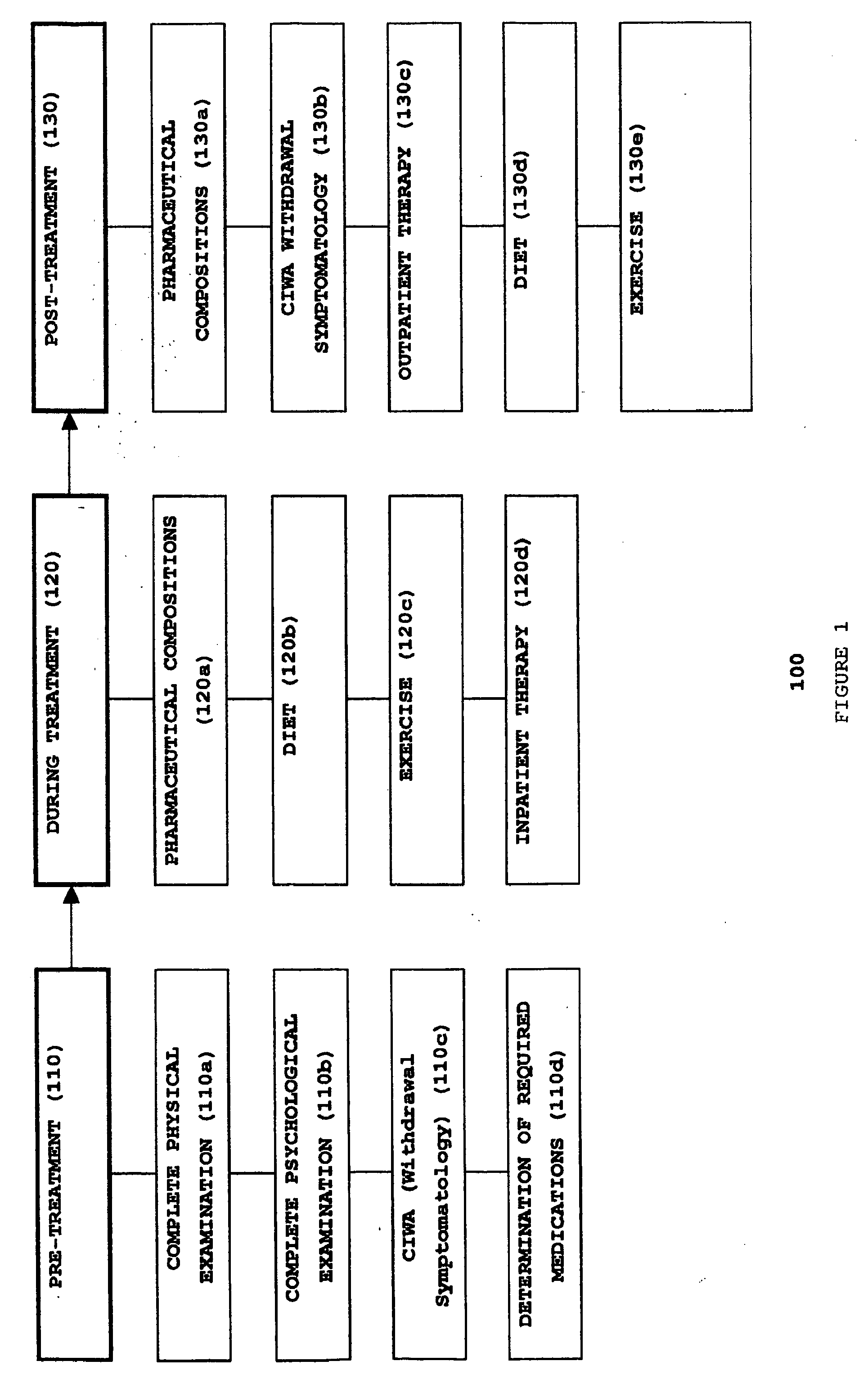Use of Selective Chloride Channel Modulators to Treat Methamphetamine Abuse
a technology of selective chloride channel and methamphetamine, which is applied in the direction of biocide, drug composition, peptide/protein ingredients, etc., can solve the problems of increasing the compulsion to take more drugs, depressed motivation and mood, and depressed mood, so as to reduce cravings and withdrawal symptoms, and control cravings
- Summary
- Abstract
- Description
- Claims
- Application Information
AI Technical Summary
Benefits of technology
Problems solved by technology
Method used
Image
Examples
example 1
Treatment of Patients with Flumazenil in Multiple Dosages at Predetermined Time Periods
1.1 Experimental Protocol
[0248]64 alcoholics (51 males and 13 females) voluntarily entered a treatment program to discontinue the use of alcohol. The patients were provided the appropriate information and the corresponding informed consent form was obtained from them. The patients were warned not to drink alcohol the morning on which the treatment was to be carried out to enable better evaluation of the withdrawal symptoms. Table 14 summarizes the characteristics of the patients treated associated with alcohol use.
TABLE 14Characteristics of Patients Associated with Alcohol UseSTANDARDMINI-MAXI-CHARACTERISTICSMEANDEVIATIONMUMMUMAGE (YEARS)42.710.22075AGE AT BEGINNING24.610.2671OF DAILY ALCOHOLUSE (YEARS)DAILY UNITS OF24.915.4473ALCOHOL INTAKEGAMMA-GLUTAMYL159.1227.2121.230TRANSPEPTIDASE(GGT)CORPUSCULAR97.86.472111VOLUME (RBC)NUMBER OF1.61.205PREVIOUSDETOXIFICATIONS(note: 85% consumed alcohol daily ...
example 2
Improved Methodology for the Administration of Flumazenil to Treat Alcohol Dependency
[0273]Before starting the protocol, the patients underwent a complete medical and psychological examination. The monitoring of the patients included a complete blood count, a biochemical profile [creatinine, glucose, blood urea nitrogen (BUN), cholesterol (HDL and LDL), triglycerides, alkaline phosphatase, LDH (lactic dehydrogenase) and total proteins], hepatic function tests [GOT, GPT, GGT, bilirubin), electrocardiogram and, if need be, pregnancy test and x-ray examination. The exclusion criteria applied included acute or uncompensated illnesses, as well as the taking of any drug contraindicated with flumazenil. No patient was excluded after the pre-admission interview and the tests performed.
[0274]In addition, patients diagnosed with a psychotic disorder received anti-psychotic medication. Patients diagnosed with arterial hypertension are prescribed the appropriate medication or instructed to cont...
example 3
Improved Methodology for the Administration of Flumazenil to Treat Alcohol Dependency
[0278]In accordance with this embodiment of the present invention, as related to such example, a protocol for the treatment of alcohol cravings is described in the table below:
TimeDay 3 -Admission DayDay 2DischargePre-ProcedureAtaraxAtaraxFortified(AM)(sedative) -(sedative) -Vitamin B50 mg (1-2 hour50 mg (1-2 hourcomplex.pre-procedure).pre-procedure).ProteinMay repeat withMay repeat withDrink.25 mg for25 mg foranxiety ifanxiety ifneeded.needed.FortifiedFortifiedVitamin BVitamin Bcomplex.complex.Protein Drink.Protein Drink.ProcedureFlumazenil 2 mgFlumazenil 2 mgper dayper dayPost-ProcedureAtarax 50 mg. atAtarax 50 mg. at(PM)bedtime maybedtime mayrepeat with 25 mg.repeat with 25 mg.as neededas neededfor sleep.for sleep.
[0279]At discharge, the following may be administered: disulfuram 250 mg., daily for six months; glutamic acid, 500 mg., once daily for one day, twice daily for one day, then three time...
PUM
| Property | Measurement | Unit |
|---|---|---|
| time | aaaaa | aaaaa |
| time | aaaaa | aaaaa |
| time | aaaaa | aaaaa |
Abstract
Description
Claims
Application Information
 Login to View More
Login to View More - R&D
- Intellectual Property
- Life Sciences
- Materials
- Tech Scout
- Unparalleled Data Quality
- Higher Quality Content
- 60% Fewer Hallucinations
Browse by: Latest US Patents, China's latest patents, Technical Efficacy Thesaurus, Application Domain, Technology Topic, Popular Technical Reports.
© 2025 PatSnap. All rights reserved.Legal|Privacy policy|Modern Slavery Act Transparency Statement|Sitemap|About US| Contact US: help@patsnap.com



